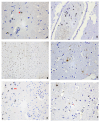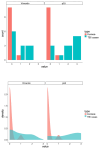Vimentin and p53 Immunoreactivity in Cases of Traumatic Brain Injury
- PMID: 40278314
- PMCID: PMC12028761
- DOI: 10.3390/jpm15040135
Vimentin and p53 Immunoreactivity in Cases of Traumatic Brain Injury
Abstract
Background: Traumatic brain injury (TBI) is one of the main causes of death in trauma pathology, especially among the youngest victims. After having evaluated the causality relationship between damage to the brain tissue and death, pathologists should try to estimate the duration between the TBI and death. Immunohistochemistry could be used in this field as a personalized medico-legal approach. This study aims to evaluate the possible role of vimentin and p53 as TBI markers to assess vitality and date the TBI. Methods: Twelve cases of TBI deaths were selected (two women and ten men, with a mean age of 46.83 years). In seven cases, death occurred immediately after the trauma, while in the others, death occurred after some days. An immunohistological study of brain samples using anti-p53 and anti-vimentin antibodies was performed. A semi-quantitative scale was adopted to grade the immunohistochemical reaction. Results: Our results showed a strong relationship between the p53 immunoreaction grade and TBI (X-squared value 10.971, p-value < 0.01), suggesting that p53 expression is enhanced in TBI cases. Vimentin is more expressed when the PTI is longer. Vimentin-immunoreaction was weaker than p53-immunoreaction (+0.75 vs. +1.83 mean values, respectively) in a group predominantly including short post-traumatic interval cases. Conclusions: The present research is limited by the small sample size; however, the molecules tested, vimentin and p53, have shown great potential to be used, in addition to others, as biological markers for the diagnosis and timing of TBI.
Keywords: forensic neuropathology; p53; traumatic brain injury; vimentin; vitality.
Conflict of interest statement
The authors declare no conflicts of interest.
Figures




Similar articles
-
Expression of RIPK-1 and S-100B in traumatic brain injury- exploring a forensic cases series.Int J Legal Med. 2025 May;139(3):1105-1112. doi: 10.1007/s00414-024-03400-2. Epub 2024 Dec 16. Int J Legal Med. 2025. PMID: 39676104
-
Analysis of miRNA Expression Profiles in Traumatic Brain Injury (TBI) and Their Correlation with Survival and Severity of Injury.Int J Mol Sci. 2024 Sep 2;25(17):9539. doi: 10.3390/ijms25179539. Int J Mol Sci. 2024. PMID: 39273487 Free PMC article.
-
Concentration of microtubule associated protein tau (MAPT) in urine and saliva as a potential biomarker of traumatic brain injury in relationship with blood-brain barrier disruption in postmortem examination.Forensic Sci Int. 2019 Aug;301:28-36. doi: 10.1016/j.forsciint.2019.05.010. Epub 2019 May 13. Forensic Sci Int. 2019. PMID: 31128406
-
[Mild traumatic brain injury and postconcussive syndrome: a re-emergent questioning].Encephale. 2012 Sep;38(4):329-35. doi: 10.1016/j.encep.2011.07.003. Epub 2011 Aug 31. Encephale. 2012. PMID: 22980474 Review. French.
-
Traumatic brain injury (TBI) in collision sports: Possible mechanisms of transformation into chronic traumatic encephalopathy (CTE).Metabolism. 2019 Nov;100S:153943. doi: 10.1016/j.metabol.2019.07.007. Metabolism. 2019. PMID: 31610856 Review.
References
-
- Hardman J.M., Manoukian A. Pathology of head trauma. Neuroimaging Clin. N. Am. 2002;12:175–187. - PubMed
-
- Menon D.K., Schwab K., Wright D.W., Maas A.I. Demographics and Clinical Assessment Working Group of the International and Interagency Initiative toward Common Data Elements for Research on Traumatic Brain Injury and Psychological Health. Position statement: Definition of traumatic brain injury. Arch. Phys. Med. Rehabil. 2010;91:1637–1640. - PubMed
-
- Turillazzi E., Manetti A.C., Turco S., Parte V. Diritto Penale della Circolazione Stradale, a Cura di Balzani Simone, Trinci Alessandro. CEDAM, Wolters Kluwer; Bitritto, Italy: 2021. Capitolo 2, La medicina legale; pp. 593–1002.
-
- Skandsen T., Kvistad K.A., Solheim O., Strand I.H., Folvik M., Vik A. Prevalence and impact of diffuse axonal injury in patients with moderate and severe head injury: A cohort study of early magnetic resonance imaging findings and 1-year outcome. J. Neurosurg. 2010;113:556–563. doi: 10.3171/2009.9.JNS09626. - DOI - PubMed
LinkOut - more resources
Full Text Sources
Research Materials
Miscellaneous

